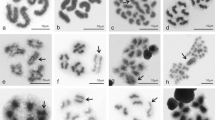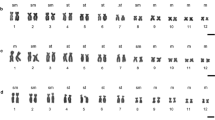Abstract
The chromosome numbers of forty-one Brazilian species belonging to 11 genera of preferentially terrestrial orchids (subfamilies Cypripedioideae, Spiranthoideae, Orchidoideae, and Vanilloideae) were examined. Previous records for these subfamilies were reviewed in order to identify the ancestral chromosome numbers of terrestrial orchids. The variation observed within the subfamilies Spiranthoideae (2n=28, 36, 46, 48 and 92), and Orchidoideae (2n=42, 44, ca. 48, ca. 80, 84, and ca. 168) was similar to that previously reported in the literature. In the subfamily Spiranthoideae, some species of Prescottia (subtribe Prescottiinae) and some genera of Spiranthinae showed a bimodal karyotype with one distinctively large pair of chromosomes. The analysis of chromosome numbers of the genera in subfamilies revealed the predominance of the polyploid series 7, 14, 21, 28, 42 with a dysploid variation of ±1 in each ploidy level. These results suggest that the basic chromosome number of terrestrial orchids is x1=7 for the subfamilies Spiranthoideae and Orchidoideae, as well as other Epidendroid orchids, and that the majority of the genera are composed of palaeopolyploids.
Similar content being viewed by others
Author information
Authors and Affiliations
Corresponding author
Rights and permissions
About this article
Cite this article
Felix, L., Guerra, M. Basic chromosome numbers of terrestrial orchids. Plant Syst. Evol. 254, 131–148 (2005). https://doi.org/10.1007/s00606-004-0200-9
Received:
Accepted:
Published:
Issue Date:
DOI: https://doi.org/10.1007/s00606-004-0200-9




